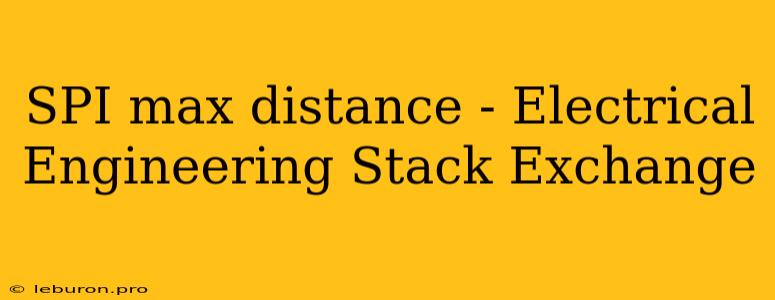Understanding the Maximum Distance Limits for SPI Communication
Serial Peripheral Interface (SPI) is a synchronous serial communication protocol widely used in embedded systems. It's known for its simplicity and versatility, making it a popular choice for connecting various peripherals to microcontrollers. However, like all communication protocols, SPI has limitations. One key limitation is the maximum distance over which it can reliably transmit data. This article will delve into the factors affecting SPI max distance and provide practical insights for engineers working with this protocol.
Factors Affecting SPI Max Distance
The maximum distance achievable with SPI is influenced by various factors, including:
1. Signal Integrity and Noise
SPI communication relies on the transmission of electrical signals between the master and slave devices. As the distance between these devices increases, the signals travel through longer wires, making them more susceptible to noise interference. This noise can corrupt data and lead to communication errors. Noise can originate from various sources, including:
- Electromagnetic Interference (EMI): Electrical devices and circuits can generate electromagnetic fields that can disrupt SPI signals.
- Capacitive Coupling: Wires act as capacitors, and they can pick up stray voltage from nearby signals.
- Ground Loops: If the ground reference points of the master and slave are not properly connected, ground loops can form, leading to current flowing through the signal wires and creating noise.
2. Signal Attenuation
As signals travel through wires, their amplitude gradually decreases. This phenomenon is known as signal attenuation. The longer the wire, the greater the attenuation. If the signal strength falls below a certain threshold, the receiving device may struggle to decode the data.
3. Clock Frequency
The clock frequency used for SPI communication directly impacts the maximum distance. Higher frequencies lead to faster data transfer rates but also increase the susceptibility to noise and signal attenuation. At higher frequencies, the signal rise and fall times become shorter, making it harder for the receiving device to detect the signal accurately.
4. Cable Type and Impedance
The type of cable used to connect the master and slave devices plays a significant role in signal integrity. Twisted pair cables are generally preferred for SPI communication, as they minimize electromagnetic interference. The characteristic impedance of the cable should match the impedance of the SPI driver and receiver to minimize signal reflections and optimize signal quality.
Practical Considerations for Maximizing SPI Distance
While SPI max distance is inherently limited, engineers can take steps to extend the range of their communication. Here are some practical strategies:
1. Shielding and Grounding
Shielded cables provide a barrier against electromagnetic interference. Proper grounding practices are crucial for minimizing ground loops and noise. A common approach is to use a single point ground reference, ensuring that all components and devices are connected to the same ground point.
2. Clock Frequency Optimization
Reducing the clock frequency can improve signal integrity and increase the maximum distance. However, this trade-off comes at the expense of data transfer rate. Selecting the optimal clock frequency involves balancing performance requirements with the need for reliable communication.
3. Signal Termination
Terminating the SPI bus with resistors can help absorb signal reflections and improve signal quality. The termination value should be chosen based on the characteristic impedance of the cable and the SPI driver.
4. Differential Signaling
In cases where long distances are unavoidable, using differential signaling can significantly improve signal integrity. Differential signaling transmits data using two wires with opposite polarity, effectively cancelling out common-mode noise.
5. SPI Driver and Receiver Considerations
The performance of the SPI driver and receiver also impacts the SPI max distance. Drivers with high drive strength and receivers with low noise sensitivity can extend the communication range.
Choosing the Right SPI Solution
Determining the appropriate SPI solution for a given application requires careful consideration of various factors. When evaluating options, consider the following:
- Distance requirements: What is the maximum distance between the master and slave devices?
- Data rate: What is the required data transfer rate?
- Environmental conditions: Will the system be exposed to noise or other environmental factors?
- Cost: What is the budget for the communication solution?
Alternatives to SPI for Long Distances
For applications requiring communication over long distances, alternative protocols may be more suitable:
- RS-485: A robust protocol designed for industrial applications, offering high noise immunity and the ability to communicate over extended distances.
- Ethernet: A widely used communication protocol offering high data rates and long-distance capability.
- CAN bus: A communication protocol commonly used in automotive and industrial applications, providing high reliability and fault tolerance.
Conclusion
Understanding the factors affecting SPI max distance is essential for engineers designing embedded systems. While SPI is a versatile and efficient protocol, it's crucial to consider the limitations imposed by signal integrity and noise. By implementing appropriate design practices and selecting the right components, engineers can optimize SPI performance and extend the communication range. In situations where longer distances are required, alternative protocols such as RS-485, Ethernet, or CAN bus may be more suitable.
